Hiking in the wilderness conjures up images of tranquil forests, babbling brooks and an unrivaled peace and solitude. Time outside is known to be beneficial to your health, but there are some risks to traveling into the great outdoors. One of the most significant issues you may encounter is poisonous plants.
There is no obvious singular rule to recognize them - they are not all bright red nor do they all have three leaves. A chance encounter with a harmful plant could put an early end to your hike. To help keep you safe, we've listed some of the most common poisonous plants on the trail and how you can identify them.
8 Golden Rules of Poison Prevention
Benjamin Franklin once said "an ounce of prevention is worth a pound of cure" when addressing fire safety and that axiom applies to poisonous plants as well. The best way to handle toxic plants on the trail is to prevent exposure to them using these common-sense tips.
1. Know your plants: know which plants are harmful so you can avoid them and minimize your exposure.
2. Don't eat unknown plants: NEVER eat a plant or berry unless you can positively identify it as being unharmful. Even then, it needs to be washed thoroughly, or potentially cooked to ensure its safe to consume.
3. Dress properly: wear long pants and shirts when possible to minimize contact with their skin.
4. Wash your hands and clothing: when you encounter an unknown and possibly harmful plant, you should wash your hands or the clothing that came in contact with the plant.
5. Be careful touching pets: pets can carry the oils of poisonous plants on their fur. When you pat them, the poison substance is transferred to your hands.
6. Don't burn unknown plants: burning a plant may get rid of it, but the smoke may contain poisonous compounds. Inhaling fumes from poisonous plants can be very hazardous.
7. Avoid making items: it may be fun to craft a nature necklace using plants and leaves, but you may regret it if you accidentally used a poisonous plant in your creation.
8. Carry Tecnu: Tecnu is an effective wash that'll decontaminate your skin, your pet's fur, clothing or gear.
You have to research the toxic plants that are native to the area in which you are hiking and then learn to recognize these plants in the wild. Our guide breaks down these harmful plants by the symptoms that they cause.

Plants that Affect the Skin
These plants affect your skin causing rashes, itching, and swelling when you come in contact with them.
Poison Ivy

"Leaves of three, let them be" is an old adage to follow if you want to avoid coming into contact with the common poisonous plant. Other plants have this characteristic too, but it is safest to just avoid touching plants with three leaves. Poison ivy usually has a single large center leaf with two smaller ones on the sides. The shape of the leaf varies but they all end in a point. The leaves start off reddish in color in the spring, green in the summer and yellow/orange in the fall. It can leave to some seriously itchy skin for long periods of time. Poison ivy is widespread and found everywhere in the US except Hawaii, Alaska, and parts of the southwestern deserts.

Poison Oak
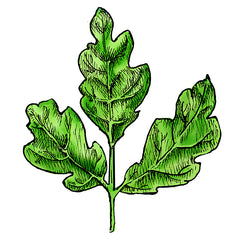
Similar to poison ivy, poison oak also has three leaves with a large middle leaf and two smaller side leaves. Poison oak gets its name from the lobed leaves which resemble the leaves from the oak tree. The leaves have hair on both sides are ten to be a duller green color than poison ivy. Similar to poison ivy, poison oak is widespread across the US.

Poison Sumac

Poison sumac usually grows as a tree, five to twenty feet high, in swampy areas. The stems are red and have multiple leaves that are smooth edged and not lobed or toothed. It can be found in the eastern and southern united states.

Wild Parsnip
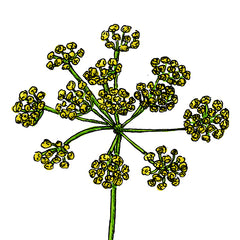
Wild parsnip is a member of the parsley family which includes carrot, celery, and dill. It can grow up to five feet tall and has yellow flowers that form an umbrella-shaped cluster. It is found in a wide range of habitats including fields, pastures, and roadsides. The sap of wild parsnip makes a person’s skin more sensitive to sunlight. Those who have contact with the wild parsnip often don’t realize it until they break out in a blistering rash after spending a short time in the sun. The plant is found throughout North America.

Giant Hogweed
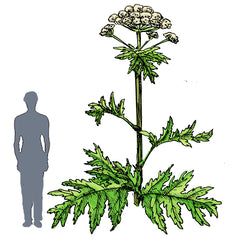
As its name implies, the giant hogweed can grow up to 14 feet tall and five feet across. It produces a white umbrella-shaped flower cluster with up to 50 rays per cluster. The leaves are lobed and measure up to five feet wide. Contact with the sap of the giant hogweed can cause blisters, burns and even scarring. The plant is found in New York, Pennsylvania, Ohio, Maryland, Oregon, Washington, Michigan, Virginia, Vermont, New Hampshire, and Maine.

Stinging Nettle
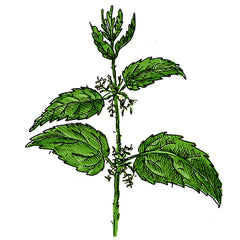
Stinging nettles are aptly named. Hairs on the plant will sting you when you come in contact with them. These hairs cover the entire plant making it easy to spot in the wild. The stinging nettle grows in dense clusters reaching up to eight feet tall. The leaves are between two and five inches long with a heart-shaped base and pointed tips. It is found in rich, moist soil in woodlands, along trails, and on riversides.

Plants that Affect the Digestive Tract
These plants will irritate your digestive tract causing vomiting, nausea, swelling of the gastrointestinal tract, and similar uncomfortable symptoms.
Manchineel

The Machineel is regarded as the most dangerous tree in the world because of the strong toxins found in almost all parts of the tree. The acidic sap can cause blisters on the skin and blindness if it gets in your eyes. A bite of the small greenish-yellow fruit can be fatal, and the smoke from burning the branches and leaves can damage the eyes and lung. A tropical tree, the Machineel is native to Florida and is called the beach apple because it resembles an apple tree and is found along the coast and in salt-water swamps.

Elderberry
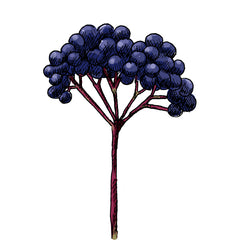
Though cooked elderberries are edible, the remaining parts of the plant and its uncooked berries contain glycosides that turn into cyanide when consumed. The elderberry can be recognized by its distinctive umbrella-shaped cluster of purple-black berries. It also has compound leaves that have one leaf at the top and pairs of leaves opposite each other along the stem. In the spring and early summer, the yellowish-white flowers grow as a flat-topped cluster or umbel. It is commonly found in fields and shady areas throughout the US.

Castor Bean
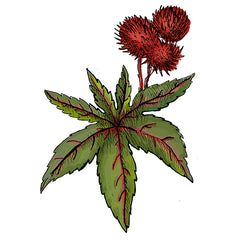
Castor beans contain ricin, one of the most toxic naturally-occurring substances known to man. The oil is used medicinally, but only because the ricin toxin is removed during processing. When eaten raw, even a single ounce of the castor bean seed can be fatal. The plant is an ornamental woody shrub with star-shaped glossy green leaves and feathery flowers that grow in clusters at the tops of the stem. Native to Africa, the plant was introduced to North America and is found in eastern and southern part of the US. You can see it growing in disturbed areas along river beds, in fields or at the edge of cultivated fields.

Daffodil
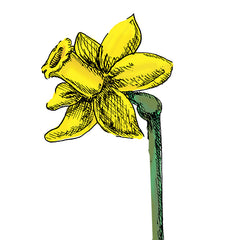
This spring favorite is a common cause of poisoning, especially among pets. Eating any part of the plant, including the bulb, can cause gastrointestinal distress. Daffodils are found throughout North America in a variety of habitats. It is among the first to flower in the spring, sprouting with a colorful, showy flower on top of a long green stalk. 
Water Hemlock/Poison Hemlock

Water hemlock (also known as poison hemlock) is in the same family as carrots, parsnips, parsley, and fennel. Note it is not related to the hemlock tree. It is easily confused with Queen Anne’s lace (wild carrot) and yarrow, which are commonly foraged for their edible and medicinal qualities. Water hemlock is found across the continental US and is widespread.
It can grow up to eight feet high and has hairless stems and lacy leaves. The stems also may have a purplish splotching. The flowers bloom in an umbrella-shaped cluster that resembles Queen Anne’s lace. Queen Anne's lace is slightly different - it will have a hairy stem and often a single dark red/purple flower in the center of each umbel. It also tends to be shorter growing, only two to three feet in height. Yarrow has white flowers in an umbel similar to water hemlock, but the flowers grow closer together, almost forming a ball in the center. Yarrow also has smooth stems and more feathery leaves that water hemlock. You can touch water hemlock, but do not ingest it.

Iris

Iris plants are easily recognized because of their showy flowers that have three large colorful sepals and three interior petals that droop downward. All species of the Iris contain a toxic compound that is concentrated in the roots. In the wild, the Iris is found across North America on grassy slopes, meadows, bogs, and along riverbanks.

Jack-in-the-Pulpit

Once you know what to look for, you can't miss Jack-in-the-Pulpit in the woods. The flower is only three to four inches tall with a tubular base (Jack) and a hood (pulpit) that curves over the tube. This hood is green with white or purplish stripes. The plant has several big, showy leaves that often obscure the flower. It is found in moist woodland areas in North America and contains a calcium oxalate toxin that is found primarily in the roots. You can touch the plant, but don't eat it.

Wild Poinsettia
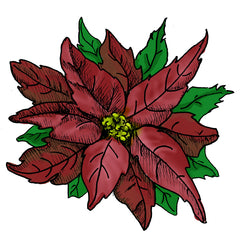
Also known as Fire on the Mountain, Wild Poinsettia has lobed leaves with irregular red blotches on the base of the uppermost leaves. It releases a milky sap that aids in identification. It is toxic as well as irritating to the skin. Poinsettia is native to the tropical climates of South America, but it can be found in the southern part of the United States.

Pokeweed
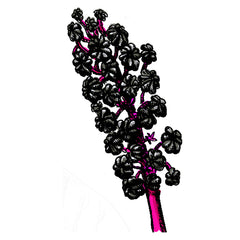
Native to the eastern United States, Pokeweed is known for its large lance-shaped leaves, long red-purple stems (can be up to ten feet high) and its dark purple berries (they grow in a grape-like cluster). It is often found in disturbed soils on roadsides, in pastures, and along the border of woods. The raw berries, roots and mature plants are poisonous.

Rosary Pea

Native to India, Rosary Pea was introduced to the United States where it is considered an invasive weed. It grows in pastures, abandoned farms, roadsides, and similar disturbed areas. The seeds of the rosary pea are highly toxic - a single seed could kill you. The plant has a distinctive red and black pea that is so uniform in size that it is used as a standard for weight measurement.

White Snakeroot

White snakeroot is part of the Aster family which also includes daisies. It grows up to three feet tall with thin stems and large egg-shaped leaves that have toothed edges and pointed tips. The flowers grow as clusters with tiny, hairy protrusions. It is found in the eastern parts of North America where it grows wild in forests and wooded pastures. The leaves and stems of the plant contain the toxin tremetol, which is extremely poisonous.

Plants that Affect the Nervous System
These poisonous plants are much more severe because they attack your nervous system causing hallucinations, seizure and, at their worst, paralysis.
Angel’s Trumpet

Angel’s Trumpet is a distinctive woody bush with trumpet-shaped flowers that hang downward like bells and release a fragrant smell at night. It is commonly used as an ornamental plant throughout the US so you are not likely to find it in the wild. Though they look beautiful, Angel’s Trumpet is fatal if ingested.

Deadly Nightshade
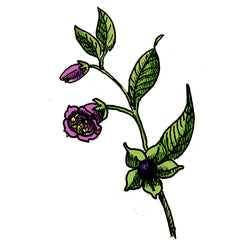
Deadly nightshade produces a cherry-like fruit which turns a shiny black color when ripened. The ground plant has light-purple bell-shaped flowers with pale green egg-shaped leaves. It is found in southern and eastern US, but it is rare.

Jimson Weed
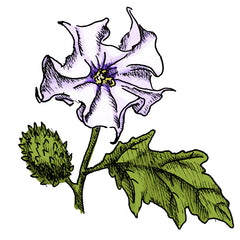
Jimson weed or devil's snare is another member of the nightshade family which is known for its poisonous members. The plant grows between two to five-feet with a thick stem and trumpet-shaped white or purple flowers. The large, irregularly lobed leaves are dark green on top, light green on the bottom and have a strong stinky smell when you crush them. The ping pong ball-sized seed pods are equally as wicked with spikes on the outside. All parts of the plant are toxic and can cause hallucinations.

Larkspur

Larkspur belongs to the buttercup family, but it is not your typical buttercup. It grows in tall spikes up to five feet with a raceme of flowers that starts near the base of the stem and extends to the top. The stem is hollow which distinguishes it from the also poisonous monkshood plant. Each larkspur flower has a distinctive dolphin-like appearance with a spur in the back. After blooming, the flowers turn into seed pods that start off green but then turn tan and papery as they ripen. Found mostly in the western and southern United States, larkspur prefers moist soils at both low and high elevations.

Corn Cockle

Originally found in Europe, corn cockle has established itself in the continental United States. It was used in folk medicines, but its toxicity makes it a dangerous remedy. The plant is covered with fine hairs on its stem. Each stem has a single deep pink to purple scentless flower with a ribbed bulb at the bottom. The flower has small black lines marking the purplish petals. The corn cockle is a hardy plant that can be found in fields and disturbed areas such as roadsides, railway lines, and more.

Plants that Affect the Heart
These are must-avoid plants due to the seriousness of their effect. A single encounter can cause cardiac arrest and other heart conditions that may hinder you or even threaten your life.
White Baneberry (Doll's Eye)
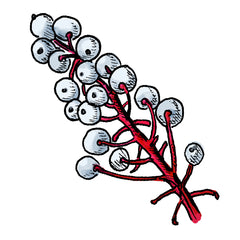
Once you learn what it is, you'll ever forget white baneberry. The plant's red stalk and its striking white berries are easy to identify in the wild. It's a good thing the berries are creepy looking - eating them can cause cardiac arrest and death. It is located in eastern North America.

Foxglove
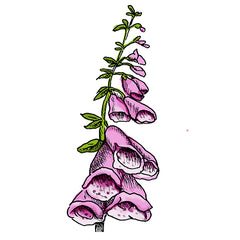
Originally from Europe, foxglove is commonly used as an ornamental plant in the united states and also grows in the wild. Foxglove is most easily recognized by its flower which grows in a cluster around a long stem. Each flower is funnel-shaped and usually points downward. They can be pink, purple, yellow or with white or purple spots on the petals. The grey-green leaves of the foxglove are typically found at the base of the plant and measure up to a foot wide. All parts of the plant are poisonous.

Monkshood
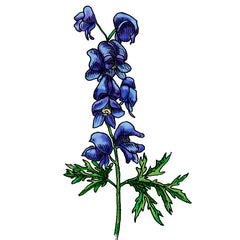
Monksood may be poisonous, but it has such an unpleasant taste that accidental poisoning is rare. You can recognize them by their distinctive purple-blue or white flowers. The flower parts are arranged in spike-like clusters with a hood shape that inspired their name. It is found in gardens as well as in the wild in the mountainous region of the United States

Mountain Laurel

In the mid-summer. the Appalachian mountains are covered with the white and rose flowers of the mountain laurel. The flowers are very showy with petals that are shaped like a bowl and contain distinct purple marking. Mountain laurel has long leaves that then to curl upward.

Oleander
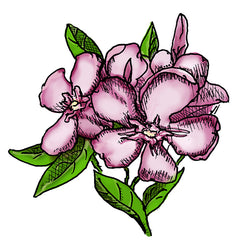
Oleander is a small, hardy shrub with long, slender, leathery leaves that are dark green in color. When it blooms, oleander has very showy, funnel-shaped flowers which is why it often is planted on roadsides. The flowers grow in single or pairs and are bright in color (white, yellow, pink, or red). You can't miss them when they are in bloom. All parts of the plant are highly toxic and should not be ingested. Oleander is found in the southern states and the west coast.

White Hellebore
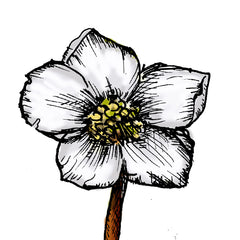
White Hellebore was used historically as a poison in ancient Greece and Rome. Hellebore has a cup-shaped flower with egg-shaped leaves that are toothed and end in a point. All parts of the plant are toxic if ingested and the seeds and sap can cause nasty chemical burns on the skin. It is found natively in Europe and Asia, but often is planted in home gardens in North America because of its showy flowers.
Though not related, American White Hellebore, also called Indian Poke or itchweed, was used by Native Americans as a medicine. They are low to the ground, growing two to three feet high and are found in swamps and wet wooded areas. When blooming, the yellow-green flowers grow in clusters at the end of each branch. You can find Hellebore all the way from Georgia to Maine and westward to Wisconsin. It also is found in Oregon, Washington, and Alaska.

Death Camas
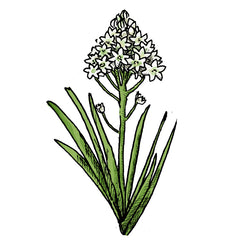
Early settlers in the west learned the hard way about death camas. Believing they were eating onion or the edible Camas plant, pioneers were surprised when they became deathly ill from their meal. Death camas has white, star-like flowers clustered at the end of a spike-like stem. The flowers have a green heart-shaped structure on each of its six petals.
Death camas has long, grass-like leaves. It resembles an onion plant and even grows from a bulb like an onion. Death camas is native in western North America and is found in mountain meadows, often next to the edible blue camas. Some varieties of the death camas also can be seen growing on rocky slopes.
What to Do If You Come in Contact With a Poisonous Plant
1. Wash: If you contact a poisonous plant, you should immediately begin washing the skin that came in contact with the plant. Find a water source or use your water to rinse the area for at least five minutes if possible. Use rubbing alcohol or detergent if you have them along with the water.
2. Monitor: After cleansing the area, watch for signs of poisoning such as a red rash, patches of blisters, itching, and swelling. If these symptoms appear, use a wet compress, calamine lotion, or hydrocortisone cream on unbroken skin to minimize itching. An oral antihistamine such as diphenhydramine (Benadryl) also can be used to reduce itching, though it may make you drowsy.
3. Seek help: If you're still experiencing symptoms, seek immediate help. Call the 24/7 Poison Help line at (800) 222-1222, consult poisonhelp.org or head to the nearest emergency medical center near you. Hikers also should have a list of emergency contacts on their phone or in their backpack.






 650-Calorie Fuel
650-Calorie Fuel